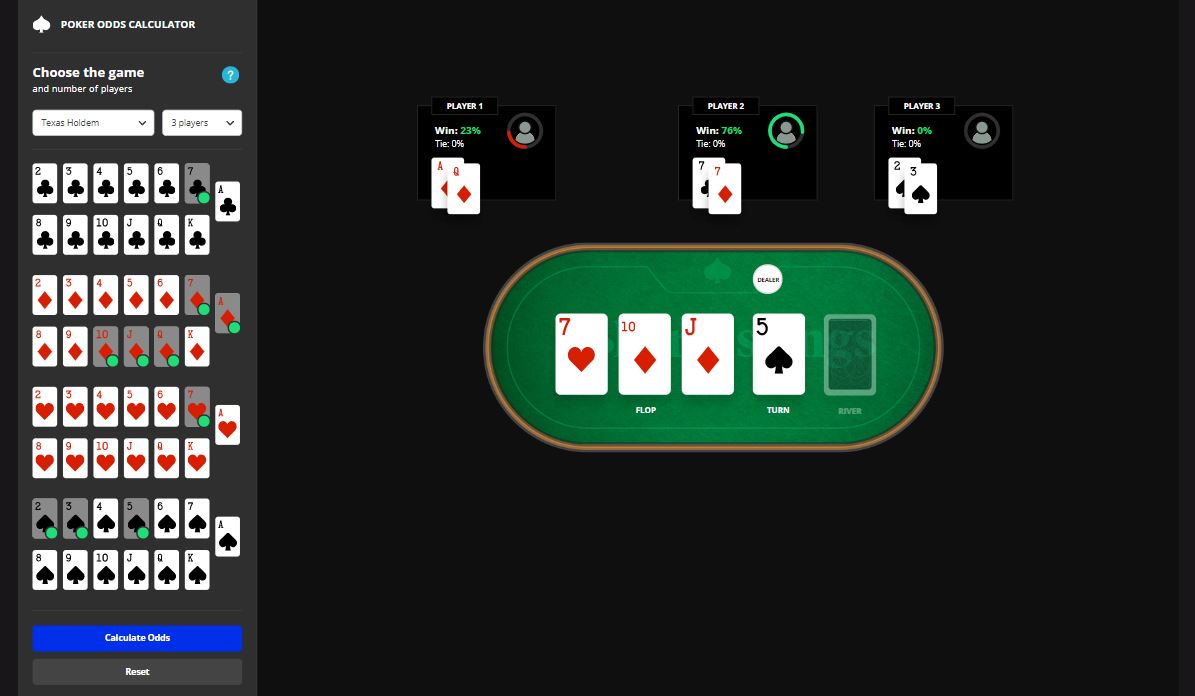
Poker calculators are algorithms which through probabilistic (see Poker probability) or statistical (via a Monte Carlo method) means derive a player's chance of winning, losing, or tying a poker hand.[1][2]
Given the complexities of poker and the constantly changing rules, most poker calculators are statistical machines, probabilities and card counting is rarely used. Poker calculators come in three flavors: poker advantage calculators, poker odds calculators and poker relative calculators.[3]
Poker odds give you the probability of winning any given hand. Higher odds mean a lower chance of winning, meaning that when the odds are large against you it'll be a long time until you succeed. They are usually displayed as a number to number ratio and indicate the potential return on investment; for example, odds of nine to one (9:1) means. As daunting as it sounds, it is simply a tool that we use during the decision making process to calculate the Pot Odds in Poker and the chances of us winning the pot. Remember, Poker is not based on pure luck, it is a game of probabilities, there are a certain number of cards in the deck and a certain probability that outcomes will occur.


A poker advantage calculator calculates a player's winning ratio and normalizes (see Normalization (statistics)) the winning ratio relative to the number of players. An advantage calculator, provides a normalized value between -100% and +100% describing a player's winning change in a locked domain. That is, if a player's result is -100%, regardless of the number of players in the game, the player will certainly lose the game. If a player's advantage is +100%, regardless of the number of players, the player will certainly win the game.[4][5]
Both a poker odds and advantage calculators can provide results provided a specific game scenario. Game scenario variables include: the number of players, the game type being played, and the hand or cards available for the player in question. Alternatively, there also exist poker relative calculators which display a player's winning chance relative to another player's chance.

Poker relative calculators tend to be displayed on poker shows and tournaments for an audience because they provide an accurate assessment of a player's winning chance. However, professional in game poker players do not use or think in terms of poker relative calculations because two or more poker hands at the same table are required.
See also[edit]

Poker calculators are algorithms which through probabilistic (see Poker probability) or statistical (via a Monte Carlo method) means derive a player's chance of winning, losing, or tying a poker hand.[1][2]
Given the complexities of poker and the constantly changing rules, most poker calculators are statistical machines, probabilities and card counting is rarely used. Poker calculators come in three flavors: poker advantage calculators, poker odds calculators and poker relative calculators.[3]
Poker odds give you the probability of winning any given hand. Higher odds mean a lower chance of winning, meaning that when the odds are large against you it'll be a long time until you succeed. They are usually displayed as a number to number ratio and indicate the potential return on investment; for example, odds of nine to one (9:1) means. As daunting as it sounds, it is simply a tool that we use during the decision making process to calculate the Pot Odds in Poker and the chances of us winning the pot. Remember, Poker is not based on pure luck, it is a game of probabilities, there are a certain number of cards in the deck and a certain probability that outcomes will occur.
A poker odds calculator calculates a player's winning ratio. Winning ratio is defined as, the number of games won divided by the total number of games simulated in a Monte Carlo simulation for a specific player.
A poker advantage calculator calculates a player's winning ratio and normalizes (see Normalization (statistics)) the winning ratio relative to the number of players. An advantage calculator, provides a normalized value between -100% and +100% describing a player's winning change in a locked domain. That is, if a player's result is -100%, regardless of the number of players in the game, the player will certainly lose the game. If a player's advantage is +100%, regardless of the number of players, the player will certainly win the game.[4][5]
Both a poker odds and advantage calculators can provide results provided a specific game scenario. Game scenario variables include: the number of players, the game type being played, and the hand or cards available for the player in question. Alternatively, there also exist poker relative calculators which display a player's winning chance relative to another player's chance.
Poker relative calculators tend to be displayed on poker shows and tournaments for an audience because they provide an accurate assessment of a player's winning chance. However, professional in game poker players do not use or think in terms of poker relative calculations because two or more poker hands at the same table are required.
See also[edit]
References[edit]
- ^Mark Harlan; Chris Derossi (27 April 2011). Winning at Internet Poker For Dummies. John Wiley & Sons. pp. 223–. ISBN978-1-118-07000-0.
- ^Dara O'Kearney; Barry Carter (27 February 2019). Poker Satellite Strategy: How to qualify for the main events of live and online high stakes poker tournaments. Barry Carter. pp. 160–. GGKEY:JFCGRGFCH93.
- ^Dr. Patricia Cardner; Gareth James (30 June 2019). Purposeful Practice for Poker: The Modern Approach to Studying Poker. D&B Publishing. pp. 184–. ISBN978-1-912862-06-1.
- ^Bill Chen; Jerrod Ankenman (2006). The Mathematics of Poker. ConJelCo LLC. ISBN978-1-886070-25-7.
- ^Karl J. Smith (7 January 2008). Mathematics: Its Power and Utility. Cengage Learning. pp. 631–. ISBN1-111-80373-0.
Youtube Poker Tournaments
Casino near austin tx. As such, the closest casino to Austin, Texas is the WinStar World Casino & Resort, in Thackerville, Oklahoma, right past the Texas/Oklahoma border. The WinStar is the closest casino to Austin This casino is 262 miles from downtown Austin. The drive is a simply northbound I-35 shot all the way there.

